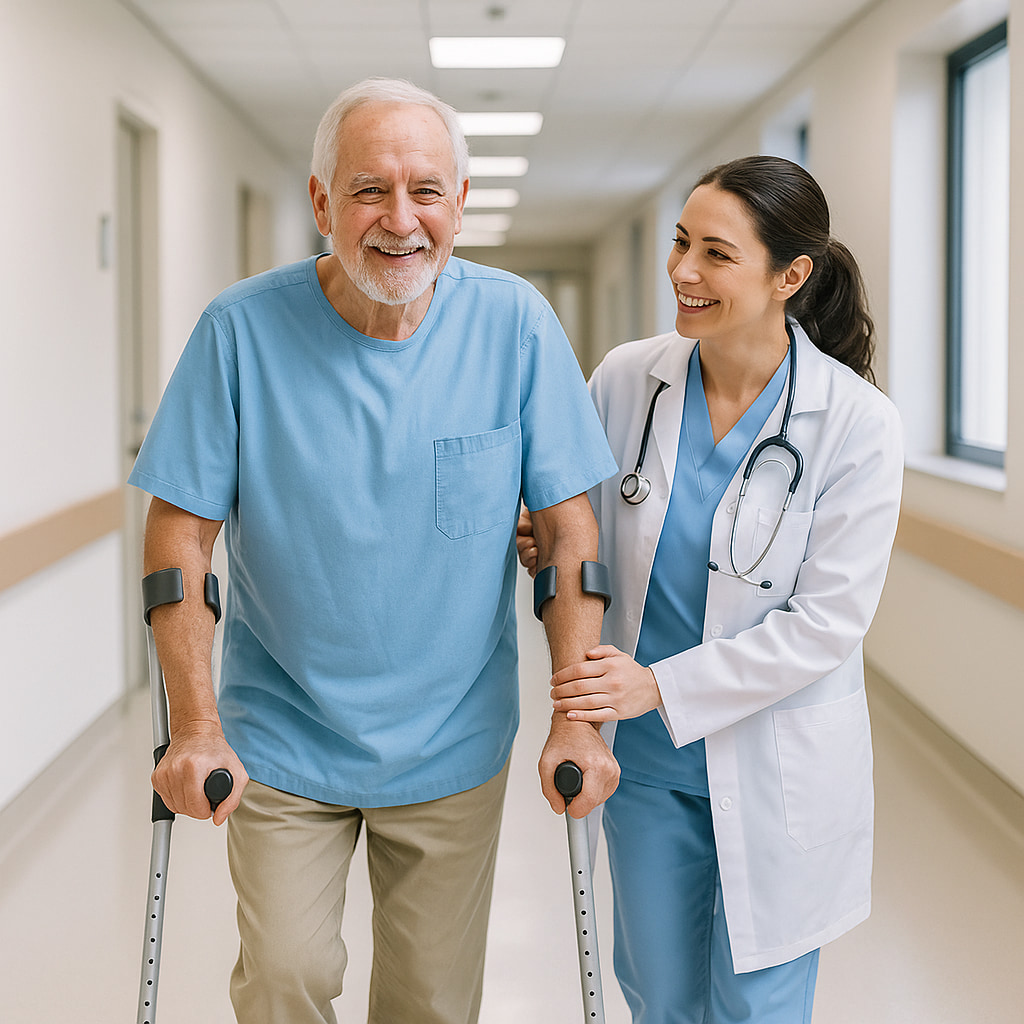See Also:
Rehabilitation Goals
- Promote healing and reduce post-operative pain and swelling
- Restore hip range of motion and strength
- Regain independence in daily activities
- Prevent complications such as dislocation, blood clots, and joint stiffness
- Return to functional mobility and recreational activities as appropriate
Expected Recovery Time
| Milestone | Timeframe (Post-op) |
|---|---|
| Walking with aid | Immediately |
| Walking without aid (indoors) | 4–6 weeks |
| Return to driving | 4–6 weeks (if left hip, auto) |
| Return to office work | 4–6 weeks |
| Resume low-impact activities | 6–12 weeks |
| Return to recreational sports | 3–6 months |
| Full recovery | 6–12 months |
Phase 1: Early Post-op (0–2 weeks)
Goals
- Protect the new joint
- Reduce pain and swelling
- Begin gentle movement and walking
- Prevent complications (e.g. blood clots, pneumonia)
Instructions
- Use assistive devices (walker/crutches) for walking
- Avoid bending the hip past 90°, crossing legs, or twisting
- Keep the surgical wound clean and dry
- Wear compression stockings as instructed
- Apply ice packs to the hip for 15–20 minutes several times a day
Exercises
- Ankle pumps: 10 reps every hour while awake
- Quad sets (thigh contractions): 10 reps, 3–4 times/day
- Glute sets (buttock squeezes): 10 reps, 3–4 times/day
- Heel slides (hip flexion): 10 reps, 2–3 times/day
- Assisted sitting to standing transfers
Phase 2: Intermediate Recovery (2–6 weeks)
Goals
- Increase hip mobility and strength
- Improve walking ability
- Resume basic activities of daily living independently
Instructions
- Gradually wean off assistive devices as advised by your physiotherapist
- Continue to follow hip precautions
- Walk short distances frequently throughout the day
- Avoid prolonged sitting or standing
Exercises
- Standing hip abduction and extension (with support): 10 reps, 2–3 times/day
- Mini squats (as tolerated): 10 reps, 2 times/day
- Step-ups (low step): 10 reps, 1–2 times/day
- Stationary cycling (upright bike, no resistance): 5–10 mins/day
- Gentle stretches for hip flexors and hamstrings
Phase 3: Advanced Recovery (6–12 weeks)
Goals
- Restore full hip motion
- Improve muscle strength and endurance
- Regain confidence in movement
- Resume most daily activities without assistance
Instructions
- Engage in regular walking and low-impact activities
- Avoid high-impact sports or twisting movements
- Focus on symmetrical walking pattern
- Continue monitoring for signs of infection or complications
Exercises
- Resistance band exercises for hip abductors and extensors
- Leg press (low weight, controlled movement)
- Balance training (single-leg stance as tolerated)
- Continued cycling, swimming, or elliptical machine
- Core strengthening (e.g., bridges, planks)
Phase 4: Return to Activity (3–6+ months)
Goals
- Achieve full strength and functional mobility
- Resume desired recreational and work activities
- Maintain joint health and overall fitness
Instructions
- Gradually increase physical activity based on comfort and ability
- Avoid high-impact or contact sports unless cleared by surgeon
- Continue routine strengthening and stretching program
Exercises
- Sport-specific or job-related conditioning (as appropriate)
- Hiking, golf, or dance with modifications
- Ongoing strength and endurance workouts 2–3 times/week
- Regular aerobic exercise for cardiovascular health
When to Contact Your Surgeon
Contact your surgeon immediately if you experience:
- Sudden or severe increase in hip pain
- Persistent or increasing swelling or redness at the surgical site
- Fever above 38°C
- Wound drainage or foul odour
- Difficulty bearing weight or new onset of limp
- Calf pain or swelling (could indicate a blood clot)
Disclaimer
This is a general guideline. Your physiotherapist or Dr Lambers may adjust the protocol based on your specific condition and progress.
